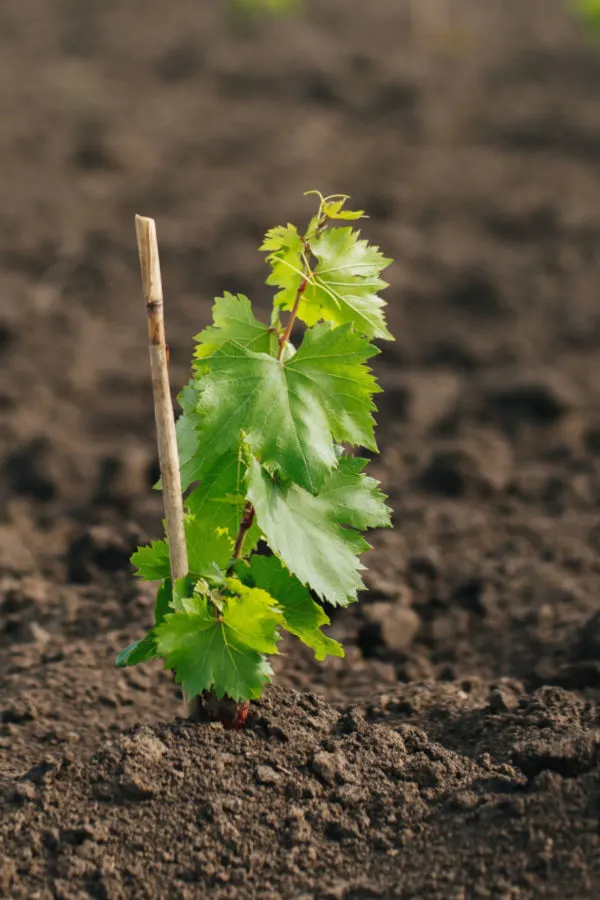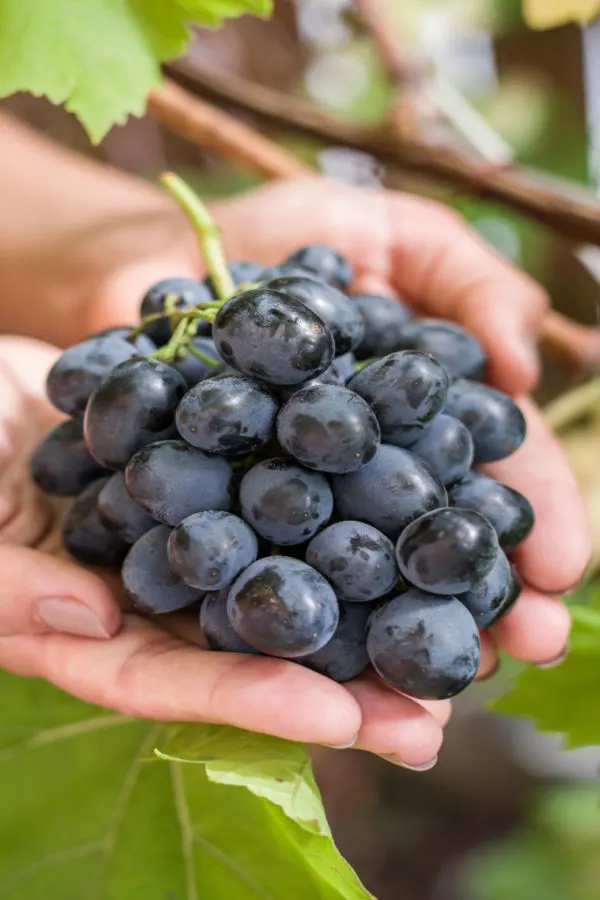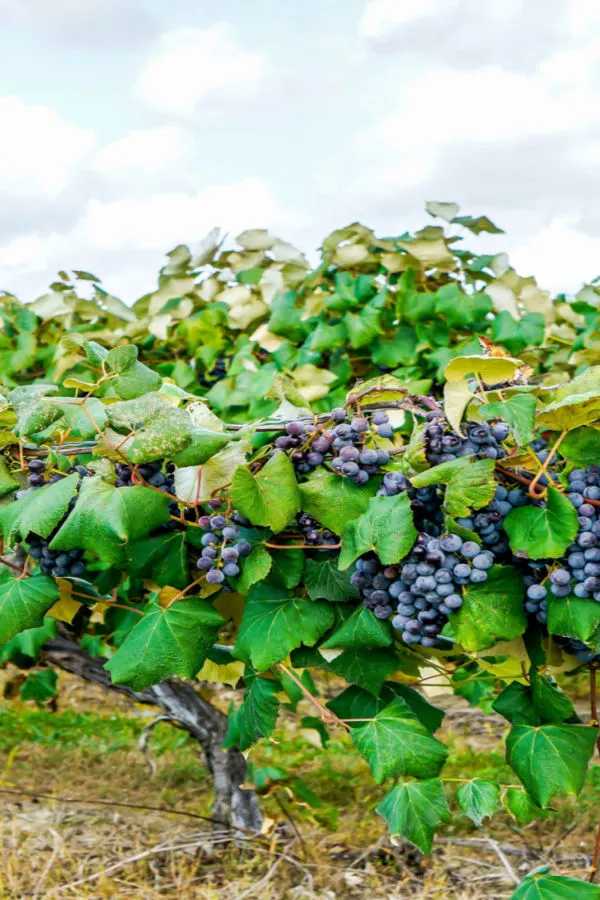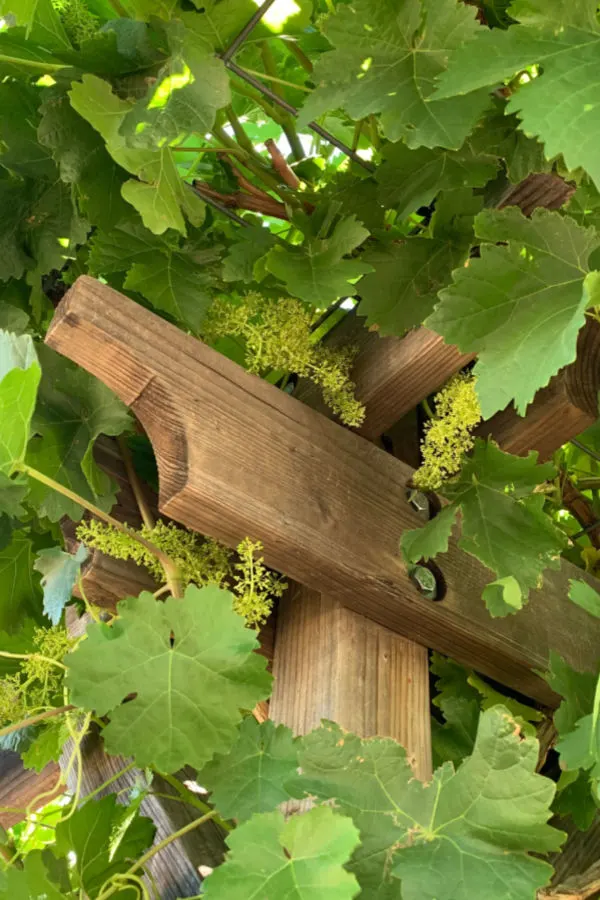Planting your own delicious crop of grapes is one of the easiest ways of all to add perennial fruit to your home landscape, especially when you consider just how simple it can be to maintain and grow your own grape vines year after year – even in the smallest of spaces!
In addition to growing a home vegetable garden, planting perennial fruits around your yard can really provide a big boost of annual food for your family. All without the hassle of having to plant and replant every single year.
Once established, grapevines can produce fruit for decades. And depending on the variety or varieties you grow, a harvest can supply you with everything from table grapes – to homemade jams, jellies, juice and yes, even wine.
The good news is that grapes really are an easy crop to plant and maintain. And they can really compliment a landscape depending on how you want to grow them. Grape vines can grow along a fence, up an arbor, trellis or pergola, or be trained up a more traditional post and wire set-up. And do they ever beautify the landscape with their large sculpted leaves and colorful ripening fruit.
When it comes to growing grapes, success comes down to making sure you grow the right variety for your climate, and planting your vines in the right area and soil to ensure good growing habits. With that in mind, here are the secrets to planting your own delicious grape vines!
Planting Grapes – How To Grow Your Own Grape Vines
Selecting The Right Variety
What variety to plant all depends on what you want to do with your grapes and where you live. Whether it be for simple eating or to make jam, juice, jelly or wine, there are varieties suited to better fill each specific need.
Grapes can be broken down into three basic varieties: European , American and Muscadine. American varieties like Concord and Mars are great for Jams and Jellies. These varieties are more tolerant to cold than most of the European varieties. Because of that, they perform well in northern states and climates with colder winters.
European selections are heavy on wine making, and a large portion of these perform better in more temperate climates. With that said, there are a lot of new varieties that can handle cold or warm – the key is to do a little research to make sure what you are planting can handle your climate.
The good news is that if you purchase your grapes locally from a nursery or store, they are more likely to be a good choice for local growing. But to be safe, always check the variety you select with your climate. Once you have your grape plants in hand – it’s time to plant!
- Affiliate Plant Link – Concord Grape Plants
- Affiliate Plant Link: Thompson Seedless Grape Plants
- Affiliate Plant Link : Muscadine Grape Plants
Selecting The Best Location – Planting Grapes
Grapes love the sun. Because of that, you want to locate your vines in an area that receives a lot of light. Morning and afternoon sun are the best choice. This allows the crop to dry off from dew quickly, helping to prevent mildew and disease. It also allows for good growth and ripening of the grapes.
When you plant your grapes is dependent upon how you buy them. If you purchase dormant, bare-root grape vines, you will want to plant them in the early spring as soon as the soil warms up and you can work the ground.
If you have purchased bare root plants that have already flowered (this often happens in nurseries or big box stores where they are stored inside), it is best to wait until the threat of a hard frost or freeze has passed before planting.

As for how to plant, both can be planted with the same method. Since grapes are a long-term perennial crop, you want to make sure the soil is prepared properly from the outset to give them years of productivity.
Preparing The Soil – Planting Grapes
When it comes to the soil, grapes don’t require a massively rich medium to grow well. In fact, as long as the soil has good draining qualities and has fair to mid-level nutrients, it will grow good grapes. The easiest way to supply them with both is by amending the planting holes with compost.
Start by digging a 10 to 12 inch diameter hole about 12 inches deep. Next, fill the bottom few inches of the hole with loose soil. For this, we like to use an equal mixture of compost, existing soil and sand. Set the grape plant in the hole, taking time to water in the roots at this point.
Watering During Planting…
Proper watering is another huge key to success. Especially when your grape vines first go in the ground. As your vine sits in the bottom of the hole, water it in well. Finish planting by filling in with a few more inches of the soil/compost/sand mix around the roots. Then tamp the soil gently around the roots
Don’t compact the soil any more at this point. This will allow it to stay loose for good drainage and circulation. It is also important to keep the crown of the plant about 1/4″ above the soil line. This keeps the crown and plant from getting waterlogged. When this occurs, it can cause the plant to rot out.

You may need to come back in a few weeks to add a little around each planting as the soil settles. This is far better than stomping the ground solid around the plant which can compact the roots leading to poor absorption of both water and nutrients.
We will cover long term support for your grape vines in the next section, but for young grape plants just planted in the soil, use a small stake to give the vine early support. Keeping it off the ground at this point can keep it from being trampled or easily attacked by pests.
Supporting Your Crop Long Term – Planting Grapes
No matter where you plant, you will need to give your grape plants long term support. This allows the grape vines to grow upward and keeps their leaves and future fruit off of the ground.
For young plants, a small rod or post right next to the vine will help it to grow when it is tender and young. Beyond that, they will need something to attach to grow longer vines and support the weight of their crop.
A simple metal or wood pole with a few wires attached between works well. As will a fence line and posts if you want to allow the grapes to meander along as they grow. Grapes are also wonderful for planting around arbors or pergolas to create a living wall or canopy of foliage and grapes.
Grapes will do well anywhere they can get sun, water and support. Just remember that grape vines can live a long time, so whatever you are using to hold them up needs to be strong, sturdy and durable. See : How To Build A Pergola With Ease!
If you are growing in rows – you will want to space your vines about 6 to 10 feet apart. If you are growing on a trellis or pergola – be sure to plant your vines out of direct foot traffic and on the outside edge of the structure. This keeps the vines out of danger as they become established.
Long Term Care – Planting Grapes
You will not get many grapes the first few years on your vines. In fact, if grapes do appear, you actually need to remove them. Keeping the vines from fruiting the first few years allows the main stem shoot and the roots to grow stronger.
Once a few years have passed, you can begin to allow your grapes to stay to harvest. It’s important to remember that birds will love your grapes as well. As they mature and grow and begin to produce after a few seasons, you will need to be prepared to put a net over them when harvest time arrives. That is if you would like to keep some of the crop for you!
Finally, you will need to prune your grapes to keep them healthy and strong. Prune in the very early stages of spring, cutting back old growth from the main canes. Grapes will only form on new shoots from the main canes – so keeping too much old growth will hamper yields.
Here is to planting a few grape vines in your landscape this year – and to enjoying the fruits of your labor for years to come! Happy Gardening – Jim and Mary.
Jim and Mary Competti have been writing gardening, DIY and recipe articles and books for over 15 years from their 46 acre Ohio farm. The two are frequent speakers on all things gardening and love to travel in their spare time.
As always, feel free to email us at thefarm@owgarden.com with comments, questions, or to simply say hello! You can sign up for our free email list in the subscribe now box in the middle of this article. Follow us on Facebook here : OWG Facebook. This article may contain affiliate links.



